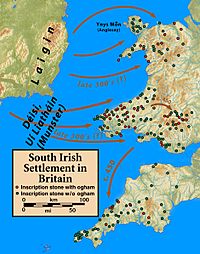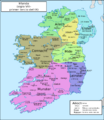Uí Liatháin facts for kids
Quick facts for kids
Uí Liatháin
|
|
|---|---|
| 4th century–c. 1220 | |
| Capital | included Castlelyons |
| Common languages | Irish |
| Religion | Celtic polytheism, Celtic Christianity (coexistent) |
| Government | Monarchy |
|
• fl. c. 340 AD
|
Eochu Liathán |
|
• 13th century
|
independent princes |
| Historical era | fl. Late Antiquity |
|
• Established
|
4th century |
|
• Disestablished
|
c. 1220 |
| ISO 3166 code | IE |
The Uí Liatháin were an early kingdom in the southern part of Ireland, specifically in a region called Munster. They were closely related to another group known as the Uí Fidgenti. Old writings, like The Expulsion of the Déisi, often talk about both groups together.
Historians have different ideas about where the Uí Liatháin and Uí Fidgenti came from. Some think they were part of the early Eóganachta family, a powerful group in Munster. Others believe they came from the Érainn or Dáirine people. It's also possible they were a mix of different families, or had a completely different origin.
The Uí Liatháin kingdom got its name from an ancestor named Eochu Liathán, which means "Eochu the Grey." He was the son of Dáire Cerbba.
Today, you can still find their name in places like Castlelyons (Caisleán Ó Liatháin) in East County Cork. This small village was one of their last important places in the High Middle Ages. The name also lives on in Killaliathan Church in County Limerick.
The two most powerful family groups within the Uí Liatháin were the Uí Meic Caille and the Uí Thassaig. After the Norman invasion of Ireland, the Uí Meic Caille gave their name to the barony of Imokilly.
Contents
Uí Liatháin in Britain
The Uí Liatháin were not just in Ireland. Old records from both Ireland and Britain show they had settlements in Wales and Cornwall. For example, the Historia Brittonum says they were forced out of North Wales by a leader named Cunedda and his sons.
Other groups were also in this part of Britain, like the Déisi and a smaller number of the Laigin. The story of the Déisi is told in Expulsion of the Déisi. While Irish records don't directly link these groups to the Uí Liatháin, it's possible they worked together, especially for trade. The Déisi Muman lived next to the Uí Liatháin in County Waterford, and the Laigin were not far away in Leinster.
The Uí Liatháin were also connected to Crimthann mac Fidaig. He was a famous King of Munster and a very powerful High King of Ireland in the 4th century. They are mentioned together in old texts and were close relatives in family records.
In 1926, a scholar named Eoin MacNeill wrote a lot about the Uí Liatháin's movements. He believed they led the Irish conquests in the south and helped start the later kingdom of Brycheiniog in Wales. He found that some Welsh family names matched Uí Liatháin leaders from Irish records. MacNeill thought that any Déisi settlements were less important until the Uí Liatháin were pushed out by Cunedda's sons. He also linked this to their cousin, Crimthann mac Fidaig, who was a powerful ruler.
Important Relationships
Bressal mac Ailello Thassaig was an early king of Munster. His sister, Angias, was the queen of Lóegaire mac Néill, who was a High King of Ireland. Angias was also the mother of Lugaid mac Lóegairi, who later became High King himself. Angias and Bressal were children of Ailill Tassach, who was the son of Eochu Liathán.
A woman named Ruithchern, who was the daughter of the King of Iarmuman, was captured by the Uí Liatháin and made to herd sheep.
At the Battle of Carn Conaill, the Uí Liatháin are listed as allies of Guaire Aidne mac Colmáin. This mention has been debated by historians.
The mother, Gormgel, and the famous wife, Caillech, of Cathal mac Finguine were both from the Uí Liatháin. Cathal mac Finguine was a very important King of Munster and King of Tara.
Later Years
A large part of the Uí Liatháin kingdom was given to the De Barry family by John of England in 1206. However, one of their family groups, the Uí Meic Tire, managed to hold onto a small area in the south for a few more decades.
Family Groups and Surnames
The two most important family groups of the Uí Liatháin were:
Uí Meic Caille
The Uí Meic Caille (also called Uí Maic Caille) gave their name to the Barony of Imokilly. They were named after Meic Caille, who was the son of Meic Brócc, who was the son of Eochu Liathán.
- Uí Meic Caille (O'Kiely, Kiely, Keily, Kiley, Keely, Kealy, Quelly)
- Uí Anmchada (Lane, Lyons, Lehane)
- Uí Glaissín (Glashan, Gleason, Gleeson)
- Uí Charráin (Ó Corráin, Curran)
Uí Thassaig
These were the descendants of Ailill Tassach, who was also a son of Eochu Liathán.
- Uí Meic Tire (Ó Mic Thíre, Mictyre, MacTyre, MacTire, Wolfe, Woulfe)
Images for kids



